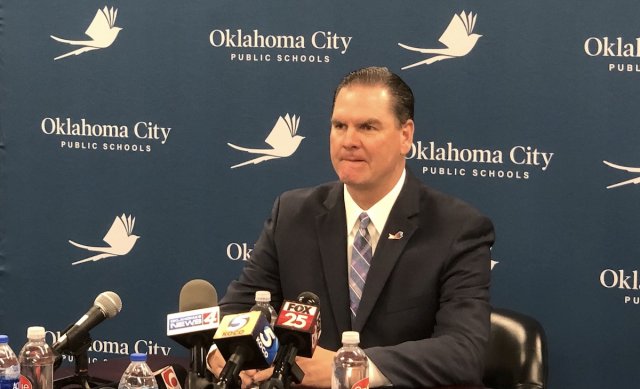

Nothing in education is more complex than the quest for safe and orderly schools. However, the last two Oklahoma City Public School District board meetings have seemed to focus on simplistic and quick fixes, implicitly blaming teachers. The district would benefit from learning from the evidence-based U.S. Office of Civil Rights’ (OCR) study of disparate suspensions, as well as what has and hasn’t worked.
When I participated in the 2016 OCR committee, we did more than push for a reduction of suspensions through training on implicit bias, classroom management, and restorative justice. The report, Civil Rights and the School-to-Prison Pipeline, drew upon the knowledge of Oklahoma educators and service providers when recommending holistic approaches for reducing suspensions. Rather than blaming teachers, the OCR respected suggestions that in-school suspension services be bolstered. It also recommended wraparound student supports in the highest-challenge schools.
Then-OKCPS Superintendent Robert Neu testified that “limiting suspensions for the sole purpose of improving statistics neglects the root of students’ inappropriate behavior — a lack of support or unmet needs.” He said, “We could lower those suspensions, but it would create chaos, and that’s why much of my testimony was focused on solutions, that we absolutely have to take a look at underlying conditions.”
Nearly four years later, the Jan. 27 OKCPS working board meeting was mostly devoted to suspensions, which Brett Dickerson of Oklahoma City Free Press reported had increased to 4,184 suspensions of 2,730 students during this academic year’s first semester. That is a 37 percent increase over last year’s first semester.
Superintendent Sean McDaniel provided a report on this year’s suspensions, stressing the positive. He acknowledged there are different ways to interpret the data, which excluded alternative placement and alternative school students. More than 91 percent of about 31,000 students weren’t suspended, perhaps calling into question complaints about fights, disruption, and disrespect. He also said the numbers might not reflect what really happened. If the teachers’ narrative is accurate, McDaniel added, it would be wrong to be immediately returning disruptive students to class without interventions.
The average suspension lasted 1.6 days. That number, he claimed, doesn’t support the narrative about fights and disrespect pushed by the Oklahoma City chapter of the American Federation of Teachers.
Such an interpretation was unfortunate, and OKCPS board members followed McDaniel’s comments by focusing primarily on better teacher training, as if it would make a meaningful difference in the highest-challenge schools.
Then, OKCPS board Chairwoman Paula Lewis noted the effect of disorder on the learning of the 91 percent of students who have not been suspended this year. Board member Carrie Jacobs cited her teaching experience in support of Lewis’ point, and board member Mark Mann pointed out the likelihood that the problem is worse in middle schools (where one in six students were suspended). As the conversation unfolded, it was noted that suspensions were not broken down by behavior — such as fighting and other serious misbehavior — and in-house suspension numbers (ISS) were requested.
New data tell different stories
During the Feb. 10 OKCPS board meeting, however, the focus was on suspension statistics. Even though the data indicated that key problems might be more than twice as bad as the previous report implied, overall school climates were mostly ignored. There were two important differences in the new numbers, but they were not discussed.
First, when all 35,000 students were counted, the finding that reassured McDaniel became worrisome. The average suspension duration wasn’t 1.6 days. It was 3.48. Second, there have been 4,367 in-house suspensions this year, so the total number of suspensions was 8,415.
The Free Press published more data showing how the 1.6 day figure was misleading. It found that “1,959 students were involved in fights at school the first semester of this school year, up 438 from the first semester of last school year.”
In the Douglass and John Marshall feeder groups, about one in five students were suspended out of school. Only about one in eleven students was suspended in the other feeders. Rebecca Budd and Mann noted that disparity, but rather than asking if disruption from the district’s new Pathway to Greatness realignment contributed to the uneven increases, it was argued that all teachers teach the “same kids,” so those schools that suspend too many should learn from those who suspend fewer.
The discussion concentrated on implicit bias, classroom management, trauma-informed instruction, and restorative justice training, plus associated costs. Those are worthy efforts, but no mention was made of the 2016 OCR study or recent analyses such as the Education Week column If you won’t do restorative justice right, don’t do it. Those sources would have called into question whether better teacher training would make much of a difference if underlying problems weren’t addressed.
McDaniel had already acknowledged that disorder in some schools is “bad.” After the meeting, he spoke with Dickerson of Free Press about the “‘brutal facts’ about suspensions.” But McDaniel indicated “the issue” which needs to be addressed has not yet been identified. Seeming to agree with the thrust of the board discussion, the superintendent called for more “training and accountability.”
‘Train and hope’ alone won’t achieve safe and orderly schools
Those statements failed to recognize how no single issue drives OKCPS’ suspension numbers. In my opinion, the worthy goal of reducing suspensions will be undermined by stressing teachers’ weaknesses, as opposed to complicated realities. “The Starts and Stumbles of Restorative Justice,” by Anne Gregory and Katherine Evans, did more than blame structural racism and bias. It noted that implicit bias is more likely to emerge in chaotic environments with “high cognitive loads, stressful environments, and decision fatigue [that] can cause people to act based on implicit biases they may not normally act on if they were in a more relaxed environment.”
Gregory and Evans describe “‘train and hope’ models that provide school staff with one to three days of training but little in-person follow-up, coaching, demonstration, or performance feedback.” They also recommended, “To improve buy-in and investment, initial efforts can engage fully supportive allies while honoring slow adopters, whose critiques and questions can help chart direction.”
OKCPS officials did not respond to my requests for more complete suspension data or a comment about their interpretation of the statistics. But American Federation of Teachers President Ed Allen did reply.
“It is disappointing to hear the tired cry that teacher training is the solution,” Allen said, calling for “real services to meet the needs of our students and their parents.”
Allen announced his retirement days later, another reminder that other community stakeholders need to pay attention to these issues.




















